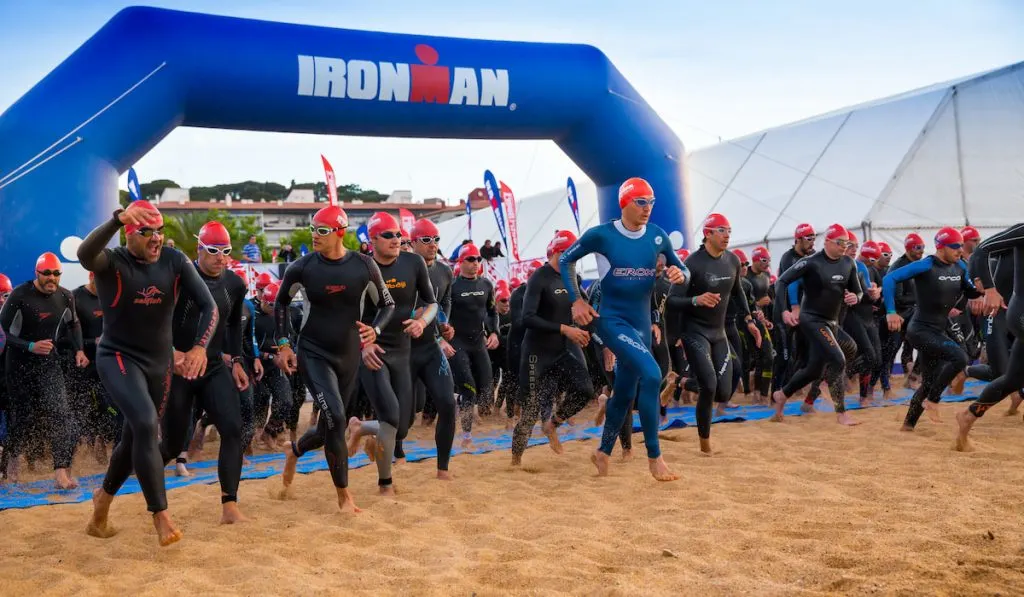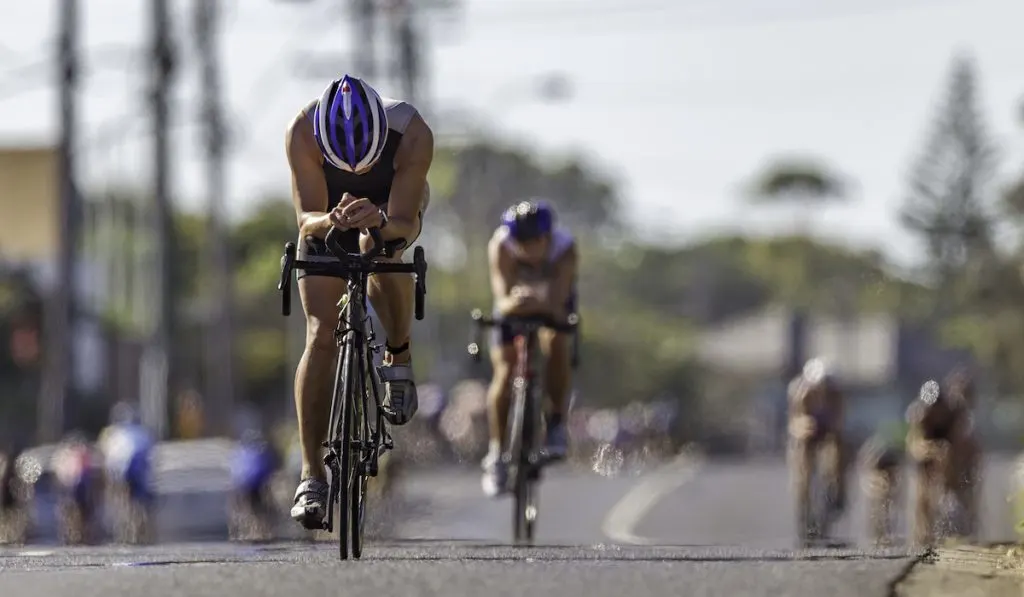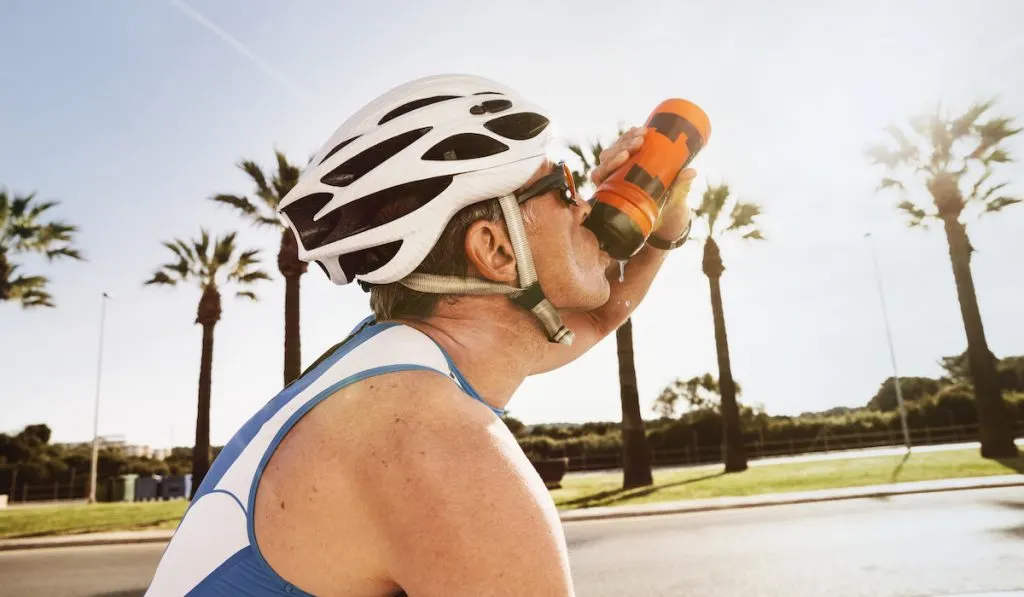If you are interested in sports, you may enjoy competing in a tri-sport. While participating in a tri-sport can be a little expensive and addictive, one question bothers many athletes, does an ironman differ from a triathlon?
Triathlon vs. Ironman, is there a difference? Yes, there is a difference between a triathlon and an Ironman. Ironman is a form of triathlon event, while triathlon is an umbrella term used to reference any tri-sport. Although they might be similar, not all triathlons are Ironman races, but all Ironman races are triathlons.
In the rest of this post, we explore the differences between an Ironman and a triathlon. We also discuss what makes up triathlon and other intricacies of triathlons.

Triathlon vs. Ironman: Is There a Difference?
As we already mentioned, there are some differences between an Ironman and triathlons.
Ironman is a type of triathlon. Compared to other types of triathlons, it takes a longer time to complete and covers longer distances.
For example, the half-Ironman triathlon covers 70.3 miles, the Olympic distance triathlon covers 32 miles. But the Ironman triathlon covers 140.6 miles. So, compared to the Ironman event, other triathlon race distances are shorter.
Next is the time required to prepare. The Ironman event covers a lot of miles and requires a whole day to complete.
The preparation and training needed is a long and essential process. To compete in an Olympic Standard Triathlon or a Sprint Triathlon, an athlete only needs a few months of training.
For these same athletes, it takes up to a year to adequately prepare for the Ironman triathlon. Beyond physical training, they also have to prepare themselves mentally.
Lastly, the recovery time for Ironman differs from that of other triathlons. Ironman is super intense, and it can take around 21 to 90 days to make a full recovery.
For a sprint marathon, the shortest distance is 16 miles which an athlete can complete in under an hour.
An athlete should take roughly 7-10 days to recover after completing a sprint marathon. Once fully rested, a sprint marathon athlete is ready to resume regular workouts until they recover fully.
One thing worthy of note here is that Ironman is a sports brand. Like many other top brands, this brand name became the common name for the activity there are known for.
Triathlon, on the other hand, is the name of multisport events. Triathlons typically involve cycling, running, and swimming.

What Makes up a Triathlon?
All triathlon events consist of three components. These components include an open-water swim, a cycling leg, and a race.
The length of these race components tends to vary from triathlon to triathlon. Unless you participate in an equilateral triathlon, the cycling aspect of a triathlon is usually the longest, followed by running.
But the swim is usually a fraction of the running and the cycling.
Triathlons also have transitions or the forgotten leg, a period where athletes switch from one race aspect to another.
There are several variations of triathlon events, and you may come across them over time.
For one, in winter, triathlons may involve cross-country skiing, mountain biking, or speed ice-skating. These aspects act as replacements for the cycling and swimming legs of the race.
Another variation of the triathlon event involves a mix of mountain biking, standup paddleboarding, and a cross-country run.

Has Anyone Died During an Ironman Triathlon?
Yes, there have been deaths in Ironman triathlons. Recent studies have shown that triathletes are more likely to suffer a cardiac arrest or fatal trauma and die suddenly.
Triathlons tend to push an athlete’s body to its limits with racing, swimming, and biking events. Some groups of athletes have a higher risk of dying suddenly than others. Any form of death can occur to athletes unexpectedly while competing in these tedious events.
Research has shown that the risk that accompanies a single triathlon is higher than the death risk of a middle-aged adult. It also exceeds the previous death estimates for long-distance races.
Most cardiac arrests and deaths in triathlons have occurred in first-time participants and middle-aged or older men. Male triathletes are known to be at a higher risk of death than female triathletes.
The majority of deaths in a triathlon occur during the swimming aspect of the race. This aspect happens to be the first component of the race.
Experts recommend athletes visit a physician for regular health checks. These health checks should include a complete health history and a full physical examination.
If they also experience heart-related symptoms, they should report it to their doctor. Some of these symptoms include lightheadedness, chest tightness, and palpitations. Other symptoms include chest heaviness/discomfort, fainting spells, and shortness of breath.

Do You Eat During an Ironman?
Yes, you can eat during an Ironman. Food items containing carbohydrates are essential for athletes to boost their endurance.
It is essential you know how much carbohydrates a portion of your desired food contains. Nonetheless, your taste buds can help you determine what you will eat.
All in all, it is best to choose products with multiple carbohydrate sources like fructose and glucose. This carbohydrate mix will help foster enhanced absorption. Products like chews, gels, and bars can help improve an athlete’s performance.
The quantity of food you take in during an Ironman should be balanced. If you take in too many calories, you risk underperforming or bonking. You may also have GI issues because your gut will have difficulty processing the nutrition.
For triathletes, a general rule of thumb is to eat about 60-90 grams of carbohydrates every hour during Ironman races. Athletes tend to consume more fluids and calories during the cycling aspect and fewer calories while running.

What Is the Easiest Part of a Triathlon?
The cycling part of a triathlon is typically the easiest aspect of the race.
Most beginners are not regular swimmers and may not be used to swimming long distances. So, swimming may not be so easy for them. But for triathletes who took up swimming regularly in the past, a 500m swim looks easy.
Most beginner triathletes are already comfortable riding a bike. While racing, getting to sit on a bike and getting rehydrated after an exhausting swim feels good. This holds, provided there is no uphill climb immediately after you leave the water.
Everyone can pretty much run. But even if you do run regularly, you may get exhausted quickly as you transition from cycling and swimming. In fact, at the point where triathletes transition to running, some of them may start walking.
In the end, the easiest aspect of a triathlon hinges on the sport that inspired an athlete to compete. Most athletes have their weakest and preferred part of a triathlon.
Which Is Tougher – an Ironman Triathlon or an Ultra-Marathon?
There have been several disagreements on which is difficult, an ultra-marathon or an ironman. Most ultra-marathon athletes claim an Ironman is easy due to the high finisher rate.
Some triathletes claim an Ironman is tougher because of the rigorous training required to get yourself to the starting line.
To find out which is tougher, we will compare the ultra-marathon and an Ironman from different aspects.
The first thing we will look at is the time it takes to complete each race. The Ironman event consists of three components totaling 140.6 miles, while the ultra-marathon refers to any race longer than 26.2 miles.
For most fit athletes that compete in both, the ultra takes roughly 3-4 fewer hours to complete than the ironman race.
Three hours is a big difference irrespective of what sport you are doing for that period. Those three hours can be crucial. In endurance racing, the longer you race, the more difficult it becomes.
During an Ironman, after running for a long time, your muscle endurance starts to break down. Each mile will then become harder than the one before.
Another aspect to consider is the transitions in an Ironman. Transitioning from cycling to running can be rather difficult, especially on a hilly course.
The time you will spend on your bike can take a toll on your legs. For an ultra-marathon, you hardly experience issues like this.
Another point to consider is the level of exertion an athlete will experience during each race. The rate of exertion experienced in an ultra-marathon is less than that of an Ironman.
Most athletes feel comfortable during ultras. Some may even hold conversations while they race.
With this explanation, we believe that an Ironman triathlon is a bit tougher than an ultra-marathon.
Resources
- https://www.ironman.com/news_article/show/1041043
- https://www.reuters.com/article/us-health-triathlons-casualties-idUSKCN1BT2LO
- https://health.clevelandclinic.org/sudden-death-during-a-triathlon-are-you-at-risk/
- https://www.clevertraining.com/blog/tri-guide-101-events-triathlon
- https://www.kitbrixusa.com/blogs/news/ironman-vs-triathlon-the-ultimate-guide
- http://spectorjosh.com/ironman-vs-ultramarathon/
